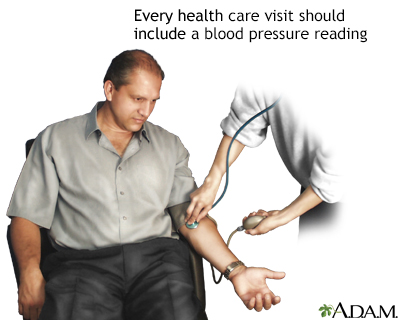Physical exam frequency
Even if you feel fine, you should still see your health care provider for regular checkups. These visits can help you avoid problems in the future. For example, the only way to find out if you have high blood pressure is to have it checked regularly. High blood sugar and high cholesterol levels also may not have any symptoms in the early stages. A simple blood test can check for these conditions.
Information

Physical exam frequency
Even if you feel fine, it still important to see your health care provider regularly to check for potential problems. Certain symptoms such as high blood sugar and high cholesterol levels often do not produce any symptoms until advanced disease has occurred.
All adults should visit their provider from time to time, even if they are healthy. The purpose of these visits is to:
- Screen for diseases
- Assess risk of future medical problems
- Encourage a healthy lifestyle
- Update vaccinations
- Maintain a relationship with a provider in case of an illness
Recommendations are based on gender and age:
-
Health screening - women age 18 to 39
Health screening - women age 18 to 39
You should visit your health care provider from time to time, even if you are healthy. The purpose of these visits is to:Screen for medical issuesAs...
 ImageRead Article Now Book Mark Article
ImageRead Article Now Book Mark Article -
Health screening - women age 40 to 64
Health screening - women age 40 to 64
You should visit your health care provider from time to time, even if you are healthy. The purpose of these visits is to:Screen for medical issuesAs...
 ImageRead Article Now Book Mark Article
ImageRead Article Now Book Mark Article -
Health screening - women age 65 and older
Health screening - women age 65 and old...
You should visit your health care provider from time to time, even if you are healthy. The purpose of these visits is to:Screen for medical issuesAs...
 ImageRead Article Now Book Mark Article
ImageRead Article Now Book Mark Article -
Health screening - men age 18 to 39
Health screening - men age 18 to 39
You should visit your health care provider regularly, even if you feel healthy. The purpose of these visits is to:Screen for medical issuesAssess yo...
Read Article Now Book Mark Article -
Health screening - men age 40 to 64
Health screening - men age 40 to 64
You should visit your health care provider regularly, even if you feel healthy. The purpose of these visits is to:Screen for medical issuesAssess yo...
 ImageRead Article Now Book Mark Article
ImageRead Article Now Book Mark Article -
Health screening - men age 65 and older
Health screening - men age 65 and older
You should visit your health care provider regularly, even if you feel healthy. The purpose of these visits is to:Screen for medical issuesAssess yo...
 ImageRead Article Now Book Mark Article
ImageRead Article Now Book Mark Article
Talk with your provider about how often you should have checkups.
Reviewed By
Jacob Berman, MD, MPH, Clinical Assistant Professor of Medicine, Division of General Internal Medicine, University of Washington School of Medicine, Seattle, WA. Also reviewed by David C. Dugdale, MD, Medical Director, Brenda Conaway, Editorial Director, and the A.D.A.M. Editorial team.
Atkins D, Barton M. The periodic health examination. In: Goldman L, Schafer AI, eds. Goldman-Cecil Medicine. 26th ed. Philadelphia, PA: Elsevier; 2020:chap 12.
Disclaimer


 All rights reserved.
All rights reserved.